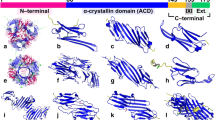Abstract.
Small heat shock/α-crystallin proteins are defined by a conserved sequence of approximately 90 amino acid residues, termed the α-crystallin domain, which is bounded by variable amino- and carboxy-terminal extensions. These proteins form oligomers, most of uncertain quaternary structure, and oligomerization is prerequisite to their function as molecular chaperones. Sequence modelling and physical analyses show that the secondary structure of small heat shock/α-crystallin proteins is predominately β-pleated sheet. Crystallography, site-directed spin-labelling and yeast two-hybrid selection demonstrate regions of secondary structure within the α-crystallin domain that interact during oligomer assembly, a process also dependent on the amino terminus. Oligomers are dynamic, exhibiting subunit exchange and organizational plasticity, perhaps leading to functional diversity. Exposure of hydrophobic residues by structural modification facilitates chaperoning, where denaturing proteins in the molten globule state associate with oligomers. The flexible carboxy-terminal extension contributes to chaperone activity by enhancing the solubility of small heat shock/α-crystallin proteins. Site-directed mutagenesis has yielded proteins where the effect of the change on structure and function depends upon the residue modified, the organism under study and the analytical techniques used. Most revealing, substitution of a conserved arginine residue within the α-crystallin domain has a major impact on quaternary structure and chaperone action, probably through realignment of β-sheets. These mutations are linked to inherited diseases. Oligomer size is regulated by a stress-responsive cascade including MAPKAP kinase 2/3 and p38. Phosphorylation of small heat shock/α-crystallin proteins has important consequences within stressed cells, especially for microfilaments.
Similar content being viewed by others
Author information
Authors and Affiliations
Additional information
Received 13 December 1999; received after revision 4 February 2000; accepted 7 February 2000
Rights and permissions
About this article
Cite this article
MacRae, T. Structure and function of small heat shock/α-crystallin proteins: established concepts and emerging ideas . CMLS, Cell. Mol. Life Sci. 57, 899–913 (2000). https://doi.org/10.1007/PL00000733
Issue Date:
DOI: https://doi.org/10.1007/PL00000733




